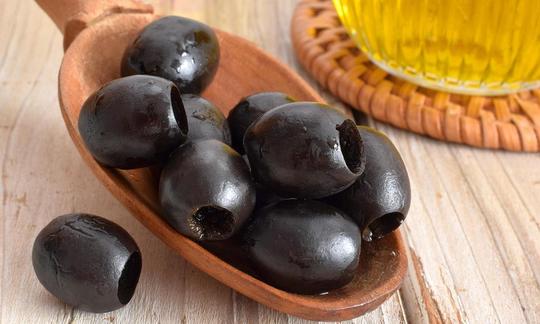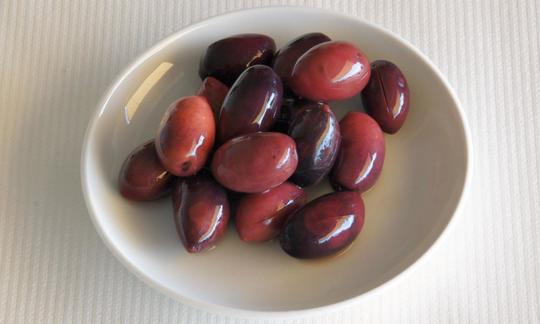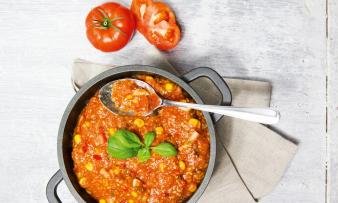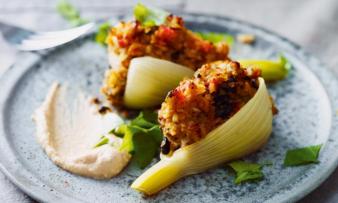Table of contents
Black olives ( Olea europaea ) are raw Edible, but due to their bitterness they are hardly palatable untreated. Therefore they are soaked in water or pickled in brine, oil or a herbal broth. Black olives are ripe fruits, softer and sweeter than green olives. Olives are available in organic quality.
Use in the kitchen
Olives are oval to round, with a length of 3-8 cm and a width of 1-2.5 cm. They are an important part of Mediterranean cuisine and are used as table olives in antipasti or as a side dish.
There are three stages of ripeness: Green olives are fruits that are harvested unripe and are hard and very bitter in taste. Olives that are in this stage of ripeness have a green to green-yellow color.
As they ripen, they turn red-brown; when processed, they appear pink, rosé or brown; some say red (red olives). They are harvested before they are fully ripe. In English, they are called turning-color olives. 23
Black olives remain on the tree longer until they are fully ripe. Their taste is sweeter and less bitter, and the flesh is noticeably softer and meatier than that of green olives. 1 They are also easier to pit. The aroma of black olives can be described as mild to intense, with a spicy to nutty note. The ripe fruits are reddish-black to violet-black, dark violet, greenish-black or appear in a deep chestnut brown. 23
However, you can also find unripe, black fruits in the store. These are olives that have been colored by the food industry. Iron-II gluconate or iron-II lactate is used to blacken the olives; it changes the taste and makes the olives last longer. 1,3
Can you eat olives raw? Freshly picked olives are not poisonous, but they are inedible. Certain processing methods, such as soaking in caustic soda or brine or soaking in water, wash out the bitter substances and make the olive fruit edible. 8
Black olives are available in stores pickled in brine or oil (e.g. olive oil ) or dehydrated, often refined with herbs and spices. If olives are pitted, they can contain different fillings such as almonds , garlic, peppers, capers, lemon peel, feta or anchovies. The stuffed varieties are very popular as antipasti, in salads or to garnish dishes. Unstuffed olives are a popular topping for pizza, pasta or bread. If you add them to stews or braised dishes, the mild to intense aroma of black olives comes out with a spicy to nutty note.
Olive paste, called tapenade, is an original French paste made from olives, capers, anchovies, garlic and olive oil . It is very popular as a spread, as a dip, in sauces or dressings and can also be made vegan (see below). Olives are also a must in a refreshing Greek salad with tomatoes, cucumbers, peppers and onions, a little fresh flat-leaf parsley and in the vegan version with tofu .
When purchasing, make sure that olives are not heated (pasteurized, sterilized), because only then are they raw in the sense of raw food quality.
Preparing your own olives
If you have fresh, raw olives straight from the tree, you can treat them yourself to make them edible and suitable for storage. The olives should be free of blemishes. We distinguish between three stages: pre-treatment (or not), watering and pickling. 14
The quickest way to remove the bitterness is to crush the olives, called tsakistes, but the black olives are too ripe for this and you have to be careful not to get splashes on your clothes. You can hit them with a wooden hammer, meat tenderizer or flat stone so that the fruit bursts but the stone remains intact. A deep tub keeps most splashes away. You can also avoid splashes by wrapping them in a fine cloth. Alternatively, you can cut the olives lengthways in three places, for example. This method is called charaktes, or sliced olives. If you fill the harvested olives directly into the brine, however, it is called kolimvites, or floating olives. This way the olives do not lose their bitterness for a long time, but remain intact. The industry uses another method: punching out the stone by machine. 14
Now you rinse the olives with fresh water in a closed container and use a weight or a container filled to the brim to ensure that all the olives are completely submerged. This removes the oleuropein. The water is changed daily for about 10 days. 14
In the third step, the olives are drained and placed in a container with brine. This should contain 7 to 10% salt to water and a teaspoon of citric acid per liter of brine or about 10% wine vinegar. The brine is made homogeneous by boiling it beforehand. Since salt cannot cause a Maillard reaction with water, the cooled brine can be classified as raw. It should contain about the same amount as the olives. 14
For flavor, you can use red wine vinegar, garlic, onions and a herb mixture such as bay leaves, oregano, thyme, fennel seeds or juniper berries . Covered with vegetable oil as the top layer and tightly sealed, olives treated in this way will keep for up to two years when stored in a cool, dark place. The squashed olives can be eaten after about 4 weeks, the cut olives after about 6 weeks and the floating ones after 2 months. However, the olives must be rinsed well before consumption. 14
Vegan recipe for olive tapenade
Ingredients (for 4 people): 100 g pitted black olives, 100 g pitted green olives, 15 g capers, 1 clove of garlic, juice of ½ lime, 1 teaspoon Dijon mustard, 1 tablespoon olive oil, 1 sprig of rosemary, 1 pinch of salt andblack pepper .
Preparation: Drain the olives and capers, chop finely and put in a bowl. Chop the garlic and add the lime juice to the olives. Then add the mustard, oil and finely chopped rosemary. Season with salt and pepper, mix well and leave in the fridge for 30 minutes. You can now enjoy the finished tapenade on baguette, as a dip, with crackers or baked potatoes. The Mediterranean spread will keep for up to four weeks in an airtight container.
Vegan recipes with black olives (raw) can be found under the note: " Recipes that have the most of this ingredient ".
| Not only vegans or vegetarians should read this: Vegans often eat unhealthily. Avoidable nutritional errors . |
Purchasing - Storage
Black olives can be found pitted or with the stone in large supermarket chains such as Coop, Migros, Denner, Volg, Spar, Aldi, Lidl, Rewe, Edeka, Hofer, Billa etc. in brine, oil or herbal broth - often also in controlled organic quality (organic quality). In organic supermarkets such as Denn's Biomarkt and Alnatura, pickled black olives without stones are available all year round, either whole or sliced, either shrink-wrapped in foil or in jars.
When buying black olives, pay attention to the additive information. The names E 579 and E 585 (iron-II-gluconate or iron-II-lactate) are colored products. 1,3 The coloured olives are pitted, much firmer in consistency, really black and cheaper than naturally ripened olives, which are irregularly coloured, more aubergine-coloured and have a less plump shape.
If you want to buy raw olives to preserve them yourself, you are more likely to find them in specialised delicatessens for Mediterranean products. The main olive season in the Mediterranean region, the main olive growing area, is from September to November . If the olives come from non-Mediterranean regions such as the USA, Australia or South America, the harvest takes place from October to February. Some regional fruits are available in Germany, Austria or Switzerland, although the harvest also takes place in autumn. However, availability is limited by the climatic challenges in most regions.
Storage tips
To preserve the aroma for as long as possible, olives should be stored in a hermetic glass or porcelain container at 6-7 °C in the refrigerator. Even pickled olives can be stored for several months. The olives should always be removed from the jars with a clean spoon and all the fruit must be covered with the liquid they contain. Opened jars can be kept for up to 2 weeks.
Ingredients - Nutritional values - Calories
Black olives are high in energy with 353 kcal/100g. The carbohydrate content is 8.7 g/100g, of which only 0.1 g sugar and 3.8 g fiber are included. The protein content is low at 2.2 g/100g. 2 In comparison, green olives contain significantly fewer calories at 139 kcal/100g. 22
There are 36 g of fat in 100 g of black olives: 3.1 g of this are omega-6 fatty acids (linoleic acid, LA ), which covers 31% of the daily requirement. In terms of omega-3 fatty acids (alpha-linolenic acid , ALA), they have a content of 0.27 g/100g, which covers 14% of the daily requirement. 2 However, this is an unfavorable fatty acid ratio of 11:1 (omega-6 to omega-3). Alternatively, seeds and nuts such as linseed or chia seeds offer a better supply of the anti-inflammatory ALA and vegetable oils such as rapeseed oil offer a much better ratio of these fatty acids. 22
With 45 µg folate per 100 g, black olives cover 23% of the daily requirement. 2 In comparison, capers have significantly less folate at 23 µg/100g. Better sources of folate are pulses such as cooked lentils with 181 µg/100g folate or green leafy vegetables such as fresh spinach with 194 µg folate per 100 g. 22
The iron content in 100 g of black olives is 1.6 mg 2, comparable to that in artichokes, which have 1.3 mg per 100 g. 100 g of dried tomatoes contain significantly more iron at 9.1 mg, which covers 65% of the daily requirement. 22
Black olives also contain 80 mg of calcium per 100 g (covers 10% of the daily requirement). 2 Almond milk has a considerable value of 139 mg/100g. The daily calcium requirement is covered in particular by consuming mineral water (33 mg/100g) or drinking water (3 mg/100g). The potassium content in olives is considered low at 40 mg/100g, similar to that in capers. 22
Essential amino acids in black olives are tryptophan and threonine .
Table olives are rich in secondary plant substances with health-promoting effects. They contain polyphenols such as the phenolic acids vanillin and caffeic acid, carotenoids and flavonoids such as luteolin, apigenin and quercetin. 4 The main phenol oleuropein is responsible for the bitter taste in unripe fruits. 9
The complete ingredients of black olives, the coverage of the daily requirement and comparison values with other ingredients can be found in our nutrient tables. In the article Nutrients explained you will get a detailed insight into the topic.
Health effects
Olives contain many valuable nutrients and are rich in unsaturated fatty acids, vitamins, carotenoids, minerals, triterpenes and polyphenols. Regular consumption of table olives could be important for human health thanks to their multiple biological activities, including antioxidant, anti-inflammatory, antimicrobial and antitumor effects. 9
To date, 36 polyphenols in five classes of secondary plant substances are known. The main groups in raw olives are phenolic acids (caffeic acid, chlorogenic acids, ferulic acid, vanillic acid, coumaric acid and syringic acid), phenolic alcohols, flavonoids and secoiridoids. 9
The phenolic alcohols hydroxytyrosol and tyrosol are the most common in olives. In processed olives, these can reach 4 g/kg. Hydroxytyrosol is formed by the hydrolysis of oleuropein when olives are pickled. It has strong antioxidant properties, contributes to immune stimulation, has antimicrobial properties and can inhibit the formation of plaque associated with atherosclerosis. 9
Olives contain important flavonoids such as luteolin-7-glucoside, cyanidin-3-glucoside, cyanidin-3-rutinoside, rutin, apigenin-7-glucoside, quercetin-3-rhamnoside and luteolin. Flavonoids have an antioxidant effect and can reduce the risk of cardiovascular diseases and cancer. 9
The group of secoiridoids in olives is represented by oleuropein and ligstroid. Oleuropein is the most important phenolic compound in leaves and unripe fruits (the content decreases with ripeness). 9 Secoiroids are pharmacologically active. They exhibit antidiabetic, antioxidant, anti-inflammatory, immunosuppressive, neuroprotective and anticancer effects. 10
Another study examined the protective effect on the cardiovascular system with a daily consumption of 5 mg of hydroxytyrosol and its derivatives (such as oleuropein and tyrosol) per 20 g of olive oil . The protection of blood lipids from oxidative stress was confirmed in the results. It should be noted that the composition of the bioactive substances in table olives differs from that in olive oil and that there are more studies on the oil than on the fruit as a functional food. A study examining different methods for measuring secondary plant substances showed that the daily consumption of 7 olives protects blood lipids from oxidative stress through 5 mg of hydroxytyrosol, tyrosol and oleuropein. 4
Remember to eat as close to nature as possible, because olives have many more nutrients than the high-calorie olive oil produced from them, as a video on healthy oils by T. Colin Campbell shows.
Blackened olives are caused by an oxidation process and by the addition of iron salts such as iron (II) lactate (E 585) or iron (II) gluconate (E 579). They therefore serve as stabilizers and not just as colorants. They stabilize the color during storage. This must be indicated to consumers in the list of ingredients or with the designation "blackened" on loose goods. Blackened olives are deep black and ripe olives are more dark brown to brown-violet in color. Are blackened olives unhealthy? The two stabilizers are classified as harmless to human health. 16,17 However, the acrylamide levels detected in black olives are worrying.
Acrylamide is normally formed by the reaction of free amino acids with carbonyl compounds (e.g. reducing sugars) via the Maillard reaction, which takes place at temperatures above 120 °C. The European Food Safety Authority ( EFSA ) classifies acrylamide as harmful to health because it increases the risk of cancer. In a study on acrylamide in colored black and green olives, the results showed very high levels of acrylamide in colored olives. The average value was 300 µg/kg, with some olives showing values over 1000 µg/kg of acrylamide. In the EU, the prescribed guideline values for acrylamide in French fries are 500 µg/kg. It should be noted that the addition of iron (II) lactate or iron (II) gluconate has no significant effect. It is suspected that the acrylamide is formed during the oxidation process and subsequent heating. 17 Why blackened olives cannot be called healthy.
Dangers - Intolerances - Side effects
Some people may be allergic to olives due to the allergens they contain or the way they are preserved. It is important to be aware of any possible intolerances.
Are olives from a jar healthy? It should be noted that olives preserved in oil are very fatty and those preserved in brine are very salty, which is why it is recommended to consume them in moderation.
Risk of confusion
To avoid confusion, it is important to pay attention to the labelling in order to distinguish coloured olives, marked by information on the stabilisers iron-II-lactate (E 585) or iron-II-gluconate (E 579) or the designation "blackened olives" from real, ripe, black olives.
Folk medicine - natural medicine
Some parts of the olive tree are considered to be diuretic in the European Mediterranean region, on the Arabian Peninsula, in India and various tropical regions and are used to treat cystitis. Olive oil and lemon juice are drunk in folk medicine to treat gallstones. The leaves are used to relieve gastrointestinal diseases or as a mouth cleaner. Dried and boiled olive leaves are used to treat diabetes 10 and high blood pressure 12 .
Ecological footprint - animal welfare
The ecological footprint of black pitted olives in brine is 1.84 kg CO 2 eq/kg. The largest part of this is due to agricultural production with 0.56 kg CO 2 eq/kg. The second largest part is due to packaging (0.51 kg CO 2 eq/kg). 20
A study to determine the environmental impact of 1 kg of bulk virgin olive oil, using the Life Cycle Analysis (LCA) tool in the agricultural and industrial phases, found that 76.3% of the environmental impact is attributable to the agricultural part. This study evaluated different cultivation practices. The CO 2 footprint ranges from 1.80-2.41 kg CO 2 eq/kg in traditional rainfed agriculture, 1.59-2.78 kg CO 2 eq/kg in irrigated agriculture and 2.28-3.26 kg CO 2 eq/kg in intensive cultivation. Olive groves act as efficient CO 2 sinks, particularly by sequestering CO 2 in tree structures. Lower intensification in traditional rainfed agriculture contributed more to mitigating the increase in atmospheric CO 2. These results refer to olive cultivation followed by oil pressing. One can conclude from the results of this study that when buying table olives, one should also make sure that the fruit does not come from intensive cultivation. We therefore recommend that you give preference to organically certified olives when purchasing. 18
The water footprint of 1 kg of olives is 3015 litres. In comparison, the water consumption for 1 kg of olive oil is significantly higher and amounts to 14,431 litres. 21
For detailed explanations of various sustainability indicators (such as ecological footprint, CO2 footprint, water footprint), see our article: What does the ecological footprint mean? .
Animal welfare - species protection
A study to investigate the influence of agricultural management on the species diversity and biodiversity of 40 selected olive groves shows that they provide habitat for many plants, insects and birds. However, the increased use of plant protection products such as pesticides, herbicides and insecticides as well as soil cultivation measures in intensive forms of cultivation are leading to a sharp decline in biodiversity. 15
Worldwide occurrence - cultivation
There are two different varieties of the olive tree ( Olea europaea ssp. europaea ) that have been known since ancient times. Firstly, the wild form ( O. europaea ssp. europaea var. sylvestris ) and secondly, the cultivated form ( O. europaea ssp. europaea var. europaea ). According to current genetic findings, the wild olive tree, also known as oleaster, is considered to be the ancestor of most of today's varieties. Where the olive comes from exactly is not clear. The genetic center is thought to be in the east of the Mediterranean, as olive remains from the Pleistocene, the Old Stone Age, have been found in the Jordan Valley. 24 There are also only assumptions about the first domestication events of the olive. Three groups of cultivated genotypes have been described: in the eastern and western Mediterranean and in the central Mediterranean regions. 13
There are isolated attempts at cultivation in the DA-CH countries, but the olive tree is mostly grown there as an ornamental plant.
Found in the wild
The oleaster ( Olea europaea ssp. europaea var. sylvestris ), a wild, shrubby olive tree, is considered the forerunner of today's cultivated olive tree. Compared to cultivated plants, the leaves and fruits of the wild olive are relatively small. They also have a bitter taste and contain very little oil. Today, olive trees in their wild form can be found in Mediterranean evergreen, dense and bushy vegetation (macchia) in the Mediterranean region. 11
Cultivation - Harvest
The olive tree is a very slow-growing crop, which in its original form is more of a shrub. With the right pruning, it grows as a tree and reaches heights of 6 to 8 meters in the plantation. It usually only bears its first fruits after seven years. Its characteristic leathery leaves are evergreen and have fine hairs on the underside. The small, fragrant flowers of the olive tree are yellowish to white. 12
Because of their origins in the Mediterranean, olive trees need a sunny, warm location that is sheltered from the wind. A nutrient-poor and dry soil are ideal conditions for shallow-rooted plants. They require very little water and do not tolerate waterlogging. Olive trees are best watered in the months of May to September during their main growth phase. They should also be fertilized twice during this time. In the olive grove, the harvest is often done mechanically using vibrating devices or combs. The harvested olives fall into nets laid out under the trees. 5
Growing in the garden or as a potted plant
If you want to plant olive trees in the garden, make sure that they come from local nurseries, as these are better adapted to the cooler temperatures. Olive trees cannot withstand temperatures below -5 °C. Outdoors, olive trees can survive the winter on a protected house wall and covered with light fleece or leaves and fir branches. During the winter break, make sure there is enough light and the root balls must not dry out. If you grow them in pots, you can let them overwinter indoors (at 5-8 °C). From mid-March, olive trees can grow in the garden or on the balcony again. 5,7
The maximum tree height of olive trees in pots is 2 m and the root depth is up to 1 m. Olive trees grow well in plastic or terracotta pots. It is important that these have a drainage hole for excess water. Ordinary garden soil mixed with sand and humus can be used. Here too, water sparingly and fertilize twice during the growing season. Organic fertilizer is suitable for fertilization, for example liquid fertilizer for potted plants such as citrus and Mediterranean fertilizers from the store. 6 Spread some gravel or expanded clay to avoid waterlogging. Pruning olive trees is more about shaping them and not regulating yield, so you can remove side branches in spring and cut back the main shoots a little. 5 If you want to harvest olives, it is a good idea to get at least two trees, as mutual cross-pollination can increase the yield. Pollination usually occurs via the wind, and a few varieties are self-pollinating. 13 In temperate climates, flowers occur from April to the end of June. Harvesting takes place by hand in autumn when the colour changes to red-violet or when the fruit is black. When the fruit is ripe, the flesh gives way when pressed and the fruit can be easily separated from the stem. 7
Industrial production
Table olives are one of the most important pickled products. Spain is the leader in production and export. There are various processing methods to remove the natural bitterness of the glycoside oleuropein from the fruit. The most common preparation methods are pickling green olives in the Spanish style (Seville style), natural black olives in the Greek style and dark-coloured (ripe) olives through oxidation by adding the stabilisers ferrous gluconate or ferrous lactate. There are also dried olives from which the water is removed with salt.
In the Spanish style, the green fruits are placed in a 2% sodium hydroxide (NaOH) solution for 12 hours to remove the bitterness. The remaining NaOH solution is then washed out with water. The green olives are then placed in brine, where they undergo fermentation. No acidifiers are used in this style. 99% of green olives are processed using this method. Popular green Spanish varieties are Gordal, Manzanilla (or Cararrasqueña) and Hojiblanca. 19 There are also other methods of making green olives edible (e.g. Picholine-style or Castelvetrano-style) in which no fermentation takes place. Green olives can also be placed directly in brine - without prior treatment. 23
How are black olives made? The Greek method is characterized by the soaking of ripening or fully ripened olives, hence black fruits, exclusively in brine. These are also natural olives in raw food quality, as the fruits ferment naturally in brine for several months. Are Kalamata olives colored? No, Kalamata olives are not colored. The method described can be used for black, ripe olives such as Kalamata olives. Furthermore, this method is also used as a processing method for organic, green olives. 19
A third possible method incorporates oxidation into the processing and is also known as "California style". Green or ripe fruits are debittered by placing them in sodium hydroxide (NaOH). This is followed by oxidation, which causes the fruits to darken. The aim is to obtain uniform, deep black fruits; the stabilizers iron-II gluconate or iron-II lactate are added for this purpose. Heating (sterilization) of the olives extends their shelf life and prevents the development of pathogens. 19,23
There are also dry, salted black olives on the market. You can buy them vacuum-packed or loose. They are also called throúmbes. Fully ripe olives that have been hanging on the tree for a long time (are dehydrated) are placed between layers of salt. The salt then extracts the water from the olives over a period of two months. This method is also used for previously debittered olives or for early ripening varieties, because the riper the fruit, the less bitter substances it contains. 19
Further information
The olive tree ( Olea europaea ) belongs to the olive family and is one of the oldest cultivated plants. In the Mediterranean region there are olive trees that are over 1000 years old. An olive tree can grow up to 20 meters high in the wild. 5
According to classification, the olive is a stone fruit. It differs from other stone fruits such as peaches, cherries or mangoes in that it has a lower sugar content and a higher concentration of oil. 9
Alternative names
Olives that are not pressed with oil are also called table olives in German-speaking countries. In English, the term table olive or olive is also used. People also often talk about edible olives, pickled olives or Kalamata olives, the latter being a special variety. They are dark purple to black and come from the Greek region of Kalamata. It is common for olives to state their origin or region.
Other uses
Olive oil is also used for ointments, emulsions, soaps or lotions. 12 The wood of the olive tree is very hard, durable and decorative - it is often used for cutting boards, bowls and dishes.
Bibliography - 24 Sources
| 1. | Spanish-Oil com: Reifegrad der Früchte – Woher kommt die Farbe in den Oliven. 2021. |
| 2. | DEBInet Deutsches Ernährungsberatungs- und Informationsnetz. Bundeslebensmittelschlüssel 3.02. Oliven schwarz roh. |
| 3. | Taste-of-koroni de: Warum werden schwarze Oliven gefärbt? 2020. |
| 4. | Moreno-Gonzales R, Juan ME, Plana JM. Table olive polyphenols: A simultaneous determination by liquid chromatography–mass spectrometry. Journal of Chromatography A. 2020; 1609:460434 |
| 5. | NDR de: Olivenbäume pflanzen und pflegen: Ein Stück Mittelmeer zu Hause. 2022. |
| 6. | Plantura.garden: Olivenbaum düngen: Richtiger Dünger & Zeitpunkt. 2023. |
| 7. | Plantura.garden: Olivenbaum: Alles zum Pflanzen, Pflegen & Überwintern. Der Olivenbaum: Ein kurzer Steckbrief. 2023. |
| 8. | Sakouhi F, Cherif A, Saadi C, Boukchina S. Assessment of the bioactive lipid profiles of oil extracted from Tunisian table olive cultivars (Barouni, Besbassi, and Marsaline cvs.). European Journal of Lipid Science and Technology. 2023;125(12):1-10. |
| 9. | Charoenprasert S, Mitchell A. Factors Influencing Phenolic Compounds in Table Olives (Olea europaea). J. Agric. Food Chem. 2012;60:7081−7095 |
| 10. | Castejon ML, Montoya T, Alarcon-de-la Lastra, Sanchez-Hidalgo M. Potential Protective Role Exerted by Secoiridoids from Olea europaea L. in Cancer, Cardiovascular, Neurodegenerative, Aging-Related, and Immunoinflammatory Diseases. Antioxidants. 2020;9(2):149. |
| 11. | Denise Vodaric. Olea europaea. Die Kraft der Olive. 2021.1-73. |
| 12. | Pahlow M. Olive. Das grosse Buch der Heilpflanzen. 8. Hamburg: Nikol Verlag; 2019:465. |
| 13. | Tourvas N, Ganopoulos I et al. Wild and cultivated olive tree genetic diversity in Greece: a diverse resource in danger of erosion. Sec. Genomics of Plants and the Phytoecosystem. 2023;14:1-18. |
| 14. | Ursula Kastanias ch: Speiseoliven selbst herstellen. 2023. |
| 15. | Tarifa R, Martínez-Núñez C et al. Agricultural intensification erodes taxonomic and functional diversity in Mediterranean olive groves by filtering out rare species. Journal of Applied Ecology. 2021;58:2266–2276. |
| 16. | Arbeiterkammer Österreich. E- Nummer, was dahinter steckt. 2023. |
| 17. | Breitling-Utzmann C, Schlag C. Salzige Angelegenheit – Salz und Acrylamid in eingelegten Oliven. Baden-Württemberg - Die Untersuchungsämter für Lebensmittelüberwachung und Tiergesundheit. 2021. |
| 18. | Fernández-Lobato L, García-Ruiz R, Jurado F, Vera D. Life cycle assessment, C footprint and carbon balance of virgin olive oils production from traditional and intensive olive groves in southern Spain. Journal of Envirnomental Management. 2021; 292:112951. |
| 19. | Sánchez Gómez AH, García García P, Rejano Navarro L. Trends in table olive production. GRASAS Y ACEITES. 2006 Mar 31;57(1):86–94. |
| 20. | Concito. The big climate database. Version 1.1. Olives, black, without stones, in brine. 2023. |
| 21. | Mekonnen M.M, Hoekstra A. Y. The green, blue and grey water footprint of crops and derived crop products. Hydrol. Earth Syst. Sci. 2011;15:1577–1600. |
| 22. | USDA United States Department of Agriculture. |
| 23. | Rejano L, Montaño A, Casado FJ, et al. Table olives. In: Olives and Olive Oil in Health and Disease Prevention. Elsevier; 2010. S. 5–15. |
| 24. | Langgut D, Cheddadi R, Carrión JS, Cavanagh M, Colombaroli D, Eastwood WJ, u. a. The origin and spread of olive cultivation in the Mediterranean Basin: The fossil pollen evidence. The Holocene. Mai 2019;29(5):902–922. |













Comments